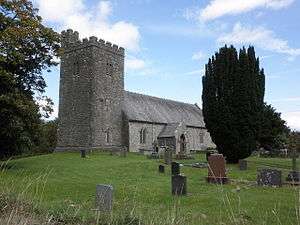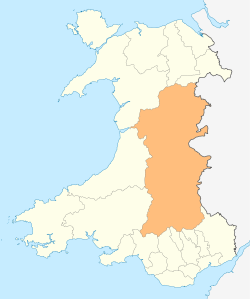Llanafan Fawr
| Llanafan Fawr | |
 St Afan's Church in Llanafan Fawr |
|
 Llanafan Fawr |
|
| Population | 470 (2011)[1] |
|---|---|
| Community | Llanafan Fawr |
| Principal area | Powys |
| Ceremonial county | Powys |
| Country | Wales |
| Sovereign state | United Kingdom |
| Post town | Llandrindod Wells |
| Postcode district | LD1 |
| Police | Dyfed-Powys |
| Fire | Mid and West Wales |
| Ambulance | Welsh |
| EU Parliament | Wales |
Coordinates: 52°11′27″N 3°30′37″W / 52.1908°N 03.5102°W
Llanafan Fawr is a civil community and ecclesiastical parish in the former cantref of Buellt (Builth) and historic county of Brecknockshire in Wales. It is now part of Powys.
The parish has an area of slightly over 5,000 hectares (12,000 acres) (about twenty square miles) and a scattered rural population of more than a thousand. It is named after Saint Afan and was the centre of Cantref Buallt in ancient times, before the building of Builth Wells about 9 miles (14 km) away. The former spa town of Llandrindod Wells is also close by.
Name
The village is also known simply as Llanafan or variantly spelled Llanafan-Fawr. In Welsh placenames, many smaller communities are named for their parish (llan), having grown up around the local church. This name of the village honours its patron saint Afan. "Fawr" is the mutated form of the Welsh mawr, meaning "big" or "great". The title distinguishes the community from the nearby Llanafan Fechan ("Little Llanafan"), although that village is now more often known as "Llanfechan".
History
Afan was a 6th-century saint supposedly related to the Cuneddan dynasty of Gwynedd.[2] His relics are claimed by the local church, which commemorates him as a bishop,[3] presumably over Brycheiniog but possibly only over the local parish. The c. 1300 inscription on the tomb reads: HIC IACET SANCTUS AVANUS EPISCOPUS.[4] He was said to have been martyred on the banks of the Afon Chwefru during an attack by Irish pirates or Danes.[2]
Governance
An electoral ward in the same name exists. The population of this ward at the 2011 census was 1,386.[5]
Church of Saint Afan
The Church of Saint Afan has been rebuilt several times. The foot of the church-tower is the only part remaining of earlier construction, the rest being rebuilt in 1886. In the porch on the right-hand wall are several carved stones which date from the 7th to 9th centuries. Inside the church, to the left of the altar, is a single pillar stone incised with a Latin ring cross, dating from the 7th century. To the right is an ancient baptismal font of similar age.
There is a 2,200-year-old yew tree in the churchyard.[6] The churchyard claims Saint Afan's relics and is also the burial place of Thomas Huet, who translated the Book of Revelation into the Welsh language in the 16th century.[7] There is also a double gravestone unique in Britain, the left-hand inscription notes that its occupant was murdered and also bears the name of his murderer: John Price Who Was Murdered On The Darren Hill In This Parish By R Lewis April 21, 1826. Relatives of both murderer and victim still live locally.[3]
Other notable sites
The Red Lion Inn is believed by some to date from at least 1188, when it was visited by Gerald of Wales. Local folklore maintains that, while staying at the inn, Gerald learned of the miracle whereby the Anglo-Norman lord Philip de Braose was struck blind and saw his hunting dogs go mad when he disrespectfully used St Afan's church as a makeshift hostel one night.[8] He was told that his vision would only return if he resolved to leave his estates and fight in the Crusades. Some say his sight was restored upon his pledge but Gerald records that he traveled to the Holy Land and fought blind, where he was "immediately struck down by a blow from a sword and so ended his life with honour".[9] From 1910 until 1991 the inn was kept by the Davies family.[10] In 2004, the inn was advertised for sale for the first time in 300 years. Also that year, television cameras were employed at the inn to record the World Tippit Championships.[6]
The vicarage for the church, formerly located beside the Afon Chewfru at the bottom of the hill, was named Persant (a corruption of Berth y Sanct, lit. "The Saint's Hedge"). It was associated with the site of Saint Afan's supposed martyrdom at the hands of invaders. In the 1700s, it housed a Latin grammar school. C. J. W. Evans, the eighty-year-old son of the last vicar to reside there, Rev Thomas Watkin Evans, witnessed the collapse of the building, after which the house was abandoned. It was later used during the Second World War by the Home Guard for hand-grenade practice.[3]
 The Red Lion Inn
The Red Lion Inn A nearby bridge across the Chewfru
A nearby bridge across the Chewfru
Agricultural Show
The Llanafan Fawr Agricultural Show is held on the third Saturday in September each year.
Notable people
The Anglo-Welsh poet T. Harri Jones was born at Cwm Crogau, in the parish Llanafan Fawr.
Link to photo of Cwm Crogau.
References
- ↑ "Community population 2011". Retrieved 11 November 2015.
- 1 2 Baring-Gould, Sabine & al. The Lives of the British Saints: The Saints of Wales and Cornwall and Such Irish Saints as Have Dedications in Britain, Vol. I, pp. 114 ff. Chas. Clark (London), 1908. Hosted at Archive.org. Accessed 18 Nov 2014.
- 1 2 3 Castles in Wales. "Llanafan Fawr".
- ↑ "AFAN". Dictionary of Welsh Biography. The National Library of Wales.
- ↑ "Ward population 2011". Retrieved 11 November 2015.
- 1 2 "Where Parched Pilgrims Rested" by David Williams, Western Mail, 24 April 2004
- ↑ Roberts, Brynley F. (2004). "Huet, Thomas (died 1591)". Oxford Dictionary of National Biography (online edition, subscription access). Oxford University Press. Retrieved 2008-02-27.
- ↑ "At this point I must tell you what happened, in the reign of Henry I, King of the English, to the castellan of Radnor castle, in the territory of Builth, which is not far away, being adjacent to his own lands, which he himself conquered. He had gone into the church of Saint Afan, called Llanafan in Welsh, and there he had spent the night with his dogs, which was a foolish and irreverent thing to do. He got up at first light, as hunters are wont to do, but he found that all his dogs had gone mad and that he himself was blind. He had lost his sight completely and he had to grope his way out with his hand..."[9]
- 1 2 Gerald of Wales (1978). The Journey Through Wales and the Description of Wales. Penguin Classics. pp. 78–79. ISBN 0-14-044339-8.
- ↑ "1932 - Davies family and Red Lion, Llanafan Fawr" at peoplescollectionwales.co.uk
External links
- Llanafan Fawr and Llanafan Fawr Castle at Castles of Wales
- Church of St Afan, Llanafan Fawr at CPAT Brecknockshire Churches Survey
- Llanafan-Fawr's entry in the 1868 National Gazetteer at GENUKI
